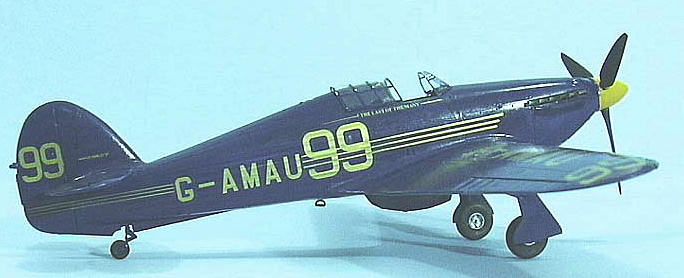
Hasegawa 1/48 Hurricane IIc 'Last of the Many'
| KIT #: | 09051/Jt 51 |
| PRICE: | about $25-30 when new |
| DECALS: | Probably two options |
| REVIEWER: | Tom Cleaver |
| NOTES: |
Lifelike Decals 48-027 “Hawker Hurricane Pt.
1" used. |

| HISTORY |
PZ865, the last Hurricane ever
built, came off the Hawkers production line at Langley, Buckinghamshire, with
the inscription “The Last of the Many” below the cockpit on left and right
sides.
The last Hurricane was first flown Langley by Group Captain P.W.S.
Bulman, Hawker’s chief test pilot who had flown the first prototype ten years
earlier, in August 1944.
A Mark IIc armed with 4 20mm cannon, the airplane was
bought back from the Air Ministry by Hawkers and was then mothballed.
In 1948, the airplane was brought back to operational
status and employed as a company communications and test hack. In late 1949,
advised that the government planned to ban the licensing of former military
combat aircraft on the civil list, Hawkers announced the Hurricane
 would be
used for public relations promotions in the newly-restarted air race circuit.
PZ865, painted in royal blue with gold trim, made its
first public appearance as G-AMAU at the Garden Party
held by the Royal Aeronautical Society at White Waltham, on May 14, 1950.
The Certificate of Airworthiness was granted on May 23,
1950, and the Hurricane was licensed as G-AMAU.
would be
used for public relations promotions in the newly-restarted air race circuit.
PZ865, painted in royal blue with gold trim, made its
first public appearance as G-AMAU at the Garden Party
held by the Royal Aeronautical Society at White Waltham, on May 14, 1950.
The Certificate of Airworthiness was granted on May 23,
1950, and the Hurricane was licensed as G-AMAU.
That year, it was entered in the
King’s Cup Air Race by HRH Princess Margaret, who was then beginning her public
career as a Royal Patrol of various activities.
The King’s Cup Air Race, which had been established by
King George V as an incentive to the development of light aircraft and engine
design.
The race, which was open to all British subjects flying a British
airplane that weighed less than 5,000 pounds and had an engine of at least 110
horsepower, was first held in 1922. The first race, held on September 8-9, was
an 810 mile event starting at Croydon Aerodrome south of London, to Glasgow,
Scotland, and back after an overnight stop. The winner of the first race was
Frank Barnard, chief pilot of the Instone Air Line, in a passenger-carrying De
Havilland D.H.4.
The contest resumed in 1949, with the event flown over
a closed course of 33 miles for five laps and a total distance of 167 miles, and
was heavily handicapped to give all contestants a chance of winning.
In the 1950 race, G-AMAU was flown
by Battle of Britain ace Group Captain Peter Townsend, and achieved second
place, losing narrowly to the Percival Mew Gull that had won the 1934 race,
which had been restored after the war. You can see Pathe footage of this event
at YouTube if you search “Peter Townsend” and “The Last of the Many.”
Following the humiliation of losing
to the restored Mew Gull, Hawkers took the opportunity following the event to
lighten the Hurricane and further streamline it by removing the redundant radio
mast.
Townsend was again sponsored by Princess Margaret for the 1951 race, but
it was canceled due to bad weather on the day of the event.
Shortly thereafter, Princess Margaret’s father, King
George VI, died, and with him died t he King’s C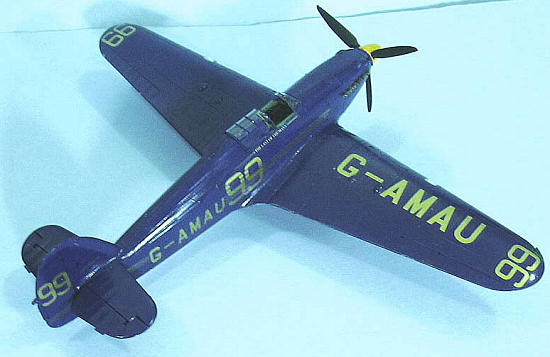 up.
The Royal Family had other matters to deal with between
then and the coronation of Queen Elizabeth in 1953 and never again sponsored an
air race.
up.
The Royal Family had other matters to deal with between
then and the coronation of Queen Elizabeth in 1953 and never again sponsored an
air race.
Following the cancellation of the
King’s Cup in 1951, PZ865 was flown at a variety of other events including a
Vintage Aircraft Rally in 1952, and another Royal Aeronautical Society Garden
Party in 1953.
Don Lucy flew it in the National Air Races in 1954 and famed
fighter and test pilot Bill Bedford flew it at the RAE Jubilee in 1955.
Through the rest of the 1950s,
PZ865 continued to be operated by Hawkers in its overall royal blue with gold
trim scheme.
Most notably, it was the chase plane for the first flight and low
speed trials of the Hawker Kestrel, which was later developed into the Harrier.
As interest in wartime aircraft began to rise in the
early 1960s, PZ865 was returned to its wartime camouflage scheme with the
original inscription.
It continued as a company “hack,” and was also flown at
various air shows by Bill Bedford.
In the mid-1960s, PZ865 was flown in the movie “The
Battle of Britain” along with the other two then-flyable Hurricanes left.
Having noticed that commenters
about this model on another site appear extraordinarily misinformed about the
story that surrounds the racing career of “The Last of the Many” and Group
Captain Peter Townsend, I’ll take a moment here and tell the story of the
romance that happened between he and Princess Margaret.
This event captured the public's imagination when
photographs of the two beaming at each other and laughing during the coronation
of Queen Elizabeth in 1953 became public.
As with any story involving the
British Royal Family, what would seem simple in any other context becomes very
complicated indeed when the Windsors are involved. Townsend, dashing and
distinguished, was divorced, which made him anathema to the Queen Mother. At
that time, Margaret was third in line for the throne, after the Queen's two
children at the time, Charles and Anne, and it was a mere 17 years since the
constitutional crisis caused by the romance of Edward VIII and Mrs. Simpson.
The royal family was still reeling from Edward VIII's
abdication in 1936 to marry Wallis Simpson, who was divorced.
The Prime Minister in 1953 was Winston Churchill, who
had been deeply involved in the 1936 crisis and was determined that no such
scandal would ever happen again.
Townsend was a genuine war hero.
A pre-war RAF pilot, he had shot down the first German
bomber to fall on British soil since 1918, when he downed a Heinkel He-111 in
late September 1939.
He went on to fly Hurricanes in the Battle of Britain
and shot down 11 enemy planes, winning the Distinguished Service Order and two
Distinguished Flying Crosses for gallantry and finally being promoted to Group
Captain before he w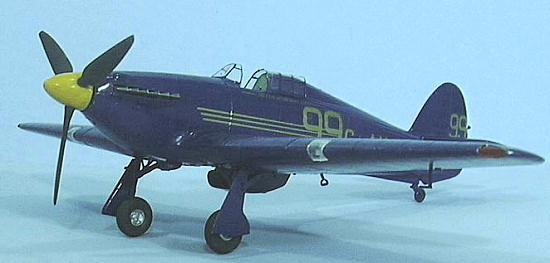 as
30.
Following the war, he sold his war medals for $35,200 and used the
proceeds to set up a fund for children who had suffered in the war.
as
30.
Following the war, he sold his war medals for $35,200 and used the
proceeds to set up a fund for children who had suffered in the war.
To his great surprise, Townsend was
sent on a three- month appointment as an Equerry to George VI in February 1944.
He and the King got along much better than had been expected, and his
appointment continued.
In 1947 the King appointed him Commander of the Royal
Victorian Order, then Deputy Master of the Household; on the death of the King
in 1952 he moved to Clarence House as Comptroller to Queen Elizabeth the Queen
Mother.
Townsend had met the
then-13-year-old Princess Margaret on his first day at Buckingham Palace when he
was 29. It was anything but love at first sight, since he considered her a
spoiled schoolgirl. During the Royal Family's tour of South Africa in 1947
people noticed that Townsend could be quite sharp with Princess Margaret.
In 1949, Margaret was expected to begin her public
career.
An enterprising representative of Hawker-Siddeley thought it would be
grand to have Her Royal Highness sponsor the company’s Hurricane, with it flown
by one of the most famous Hurricane pilots.
Thus came the racing career of PZ865.
As noted, the two grew closer by
1953, following Townsend’s divorce, and as a result of his close association
with the Princess after she, her sister Elizabeth, and the Queen Mother moved to
Clarendon House where he acted as their Comptroller.
The public saw the romance of the
two as a fairy tale come true, the love of a Princess Royal and a heroic
Commoner.
The Queen Mother, the Queen, the Government and the Church of
England saw it all very differently and were adamantly opposed.
Townsend found himself posted to Brussels as Air Attache,
Queen Elizabeth told her sister to wait a year, and the Archbishop of Canterbury
incorrectly told Margaret that she would not be able to take communion if she
were married to a divorced man.
Townsend's exile in Brussels lasted
until 1955. Under the Royal Marriages Act of 1772 Princess Margaret, on becoming
25, would have been free in August 1955 to marry without seeking the consent of
the Queen, though the marriage would still have required approval by Parliament.
In the climate of the day there was little likelihood of such approval being
forthcoming, not with the shadow of the constitutional crisis of 1936 still
hanging over the heads of the Establishment.
Had either a religious or civil marriage occurred, it
would have created many absurd anomalies - as a divorcee, Townsend would have
been refused entry to the Royal Enclosure at Ascot.
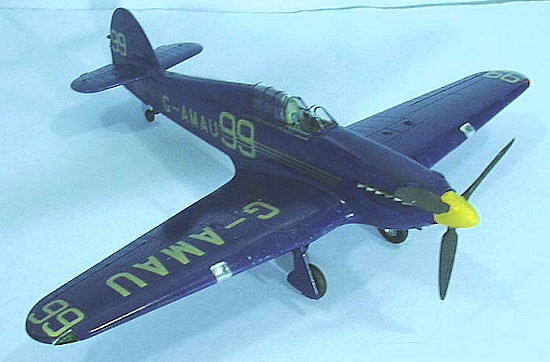 Queen Elizabeth put the screws to
her sister, informing her the marriage would mean giving up her royal rights and
income and exile from England for at least five years.
Aware of the sad life of her uncle the Duke of Windsor,
in the end Margaret issued a statement, written in pencil for her by Townsend:
"I would like it to be known that I have decided not to marry Group Captain
Peter Townsend. Mindful of the Church's teaching that Christian marriage is
indissoluble, and conscious of my duty to the Commonwealth, I have resolved to
put these considerations before any others. I have reached this decision
entirely alone, and in doing so I have been strengthened by the unfailing
support and devotion of Group Captain Townsend. I am deeply grateful for the
concern of all those who have constantly prayed for my happiness."
Queen Elizabeth put the screws to
her sister, informing her the marriage would mean giving up her royal rights and
income and exile from England for at least five years.
Aware of the sad life of her uncle the Duke of Windsor,
in the end Margaret issued a statement, written in pencil for her by Townsend:
"I would like it to be known that I have decided not to marry Group Captain
Peter Townsend. Mindful of the Church's teaching that Christian marriage is
indissoluble, and conscious of my duty to the Commonwealth, I have resolved to
put these considerations before any others. I have reached this decision
entirely alone, and in doing so I have been strengthened by the unfailing
support and devotion of Group Captain Townsend. I am deeply grateful for the
concern of all those who have constantly prayed for my happiness."
Townsend rarely spoke publicly of
Princess Margaret, but did write in his 1978 autobiography,
Time and Chance:
"She could have married me only if she had been prepared
to give up everything - her position, her prestige, her privy purse. I simply
hadn't the weight, I knew it, to counterbalance all she would have lost."
In 1959, Townsend married Marie
Luce Jamagne, a Belgian woman of whom it was said she bore a strong resemblance
to Princess Margaret.
Shortly thereafter, Margaret married Antony
Armstrong-Jones, a society photographer, who became Lord Snowdon.
Seeing her sister so unhappy over
the following years,
Queen Elizabeth decided that anyone someone in her
family wanted to marry would be acceptable, which led to the marriages of
Charles, Anne, and Andrew - all of which ended in divorce.
Gore Vidal, a friend of Margaret,
once wrote, "She was far too intelligent for her station in life." In his
memoirs Point to Point Navigation, he
recalled a conversation in which she discussed her public notoriety, saying, "It
was inevitable: when there are two sisters and one is the Queen, who must be the
source of honour and all that is good, while the other must be the focus of the
most creative malice, the evil sister."
Many say that Margaret's most enduring legacy is that she unwittingly paved the way for public acceptance of royal divorce. By the mid-1960s, most people wondered what all the fuss was about and 30 years later, when Charles divorced Diana, no one seemed upset at all.
| THE KIT |
The Hasegawa Hurricane has been around since the mid-1990s, released in all versions, and in special markings. It is commonly considered the best Hurricane in 1/48. The particular kit used here is the initial release of a Mark IIc. It is interesting to note that the decal options in this release include that of PZ865 in her original camouflage and markings as “The Last Of The Many.”
| CONSTRUCTION |
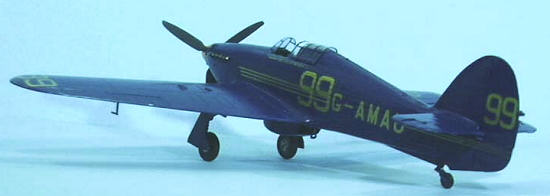 There are several reviews here at
MM of this kit.
My main interest in this project was doing it in the markings of
G-AMAU as released by Lifelike Decals.
There are several reviews here at
MM of this kit.
My main interest in this project was doing it in the markings of
G-AMAU as released by Lifelike Decals.
Checking through the Internet for
photos of the airplane, I found one taken during the 1951 King’s Cup
celebration, which revealed that the airplane lacked the radio antenna mast it
had carried in the 1950 competition, and that the exhausts had been changed,
with the six-stack exhausts associated with the late mark Spitfires substituted
for the three-exhaust cover usually associated with the Hurricane.
I used a set of metal exhausts for a P-51, and modified
the opening on the cowling so it was just a straight slot, using Evergreen sheet
plastic to change the lower line of the exhaust opening.
I also used some Evergreen sheet to
fill in the area immediately behind the cockpit, so it was shaped right with an
open canopy.
The kit canopy was replaced with a Falcon vacuform from the “RAF
Canopies Part II” collection.
I also used Eduard photoetch seat belts.
I used the alternative wing part
that does not have the cannon mountings, filling in the hole for the single
machine gun.
I also attached the cannon fairings on the upper wing since
photos show they were there, and filled in the shell ejection ports on the lower
wing.
| COLORS & MARKINGS |
Painting:
As near as I can guess from the
available photos, it is most likely the cockpit was left in British Interior
Green, for which I used
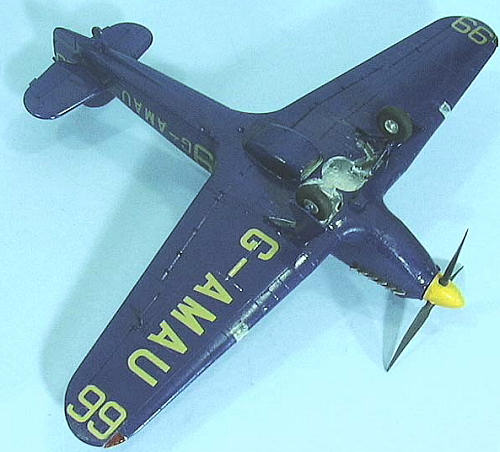 the
Xtracrylix color.
It also appears that the wheel wells would have been
left in their original aluminum lacquer.
I’ll also base that guess on my own experience that
wheel wells are a pain in the patootie to repaint, which is why they are usually
left alone.
Photos do show the inside of the gear doors the same dark color
as the rest of the airplane.
the
Xtracrylix color.
It also appears that the wheel wells would have been
left in their original aluminum lacquer.
I’ll also base that guess on my own experience that
wheel wells are a pain in the patootie to repaint, which is why they are usually
left alone.
Photos do show the inside of the gear doors the same dark color
as the rest of the airplane.
I painted the model overall Tamiya
X-4 “Blue,” which is not as dark as actual “Royal Blue,” but looks right in
“scale effect” in 1/48.
The spinner was painted with Xtracrylix “RAF Rescue
Yellow.”
As noted, the gear doors and gear legs were also painted the exterior
color.
Decals:
Lifelike Decals are done in Japan
by Keishiro Nagao.
Several people have said these decals are difficult to
find, but in fact they are easy to obtain if one orders them directly from the
Lifelike Decals website, which has a secure server for PayPal.
The decals are well researched and beautifully designed,
and go on without problem.
I used sheet 48-027m “Hawker Hurricane Part 1,” which
supplies markings for G-AMAU “The Last of the Many” in the markings used at the
King’s Cup race in both 1950 and 1951.
I chose the latter markings strictly on aesthetic
grounds, since I thought the markings were more striking.
The decals went on without problem under Micro-Sol.
| FINAL CONSTRUCTION |
I attached the landing gear,
landing lights and navigation lights, canopy and propeller, with the canopy
being mounted in the open position.
| CONCLUSIONS |
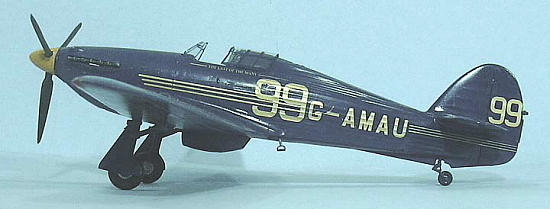 A very different Hurricane from the
others in the collection, being the only “civvie.”
The colors and markings are distinctive and result in a
very attractive model.
A very different Hurricane from the
others in the collection, being the only “civvie.”
The colors and markings are distinctive and result in a
very attractive model.
Review kit courtesy of the collection of the late kit
collector and my wallet.
Lifelike Decals provided courtesy of Keishiro Nagao. Get these and many others at
If you would like your product reviewed fairly and quickly, please contact me or see other details in the Note to Contributors.